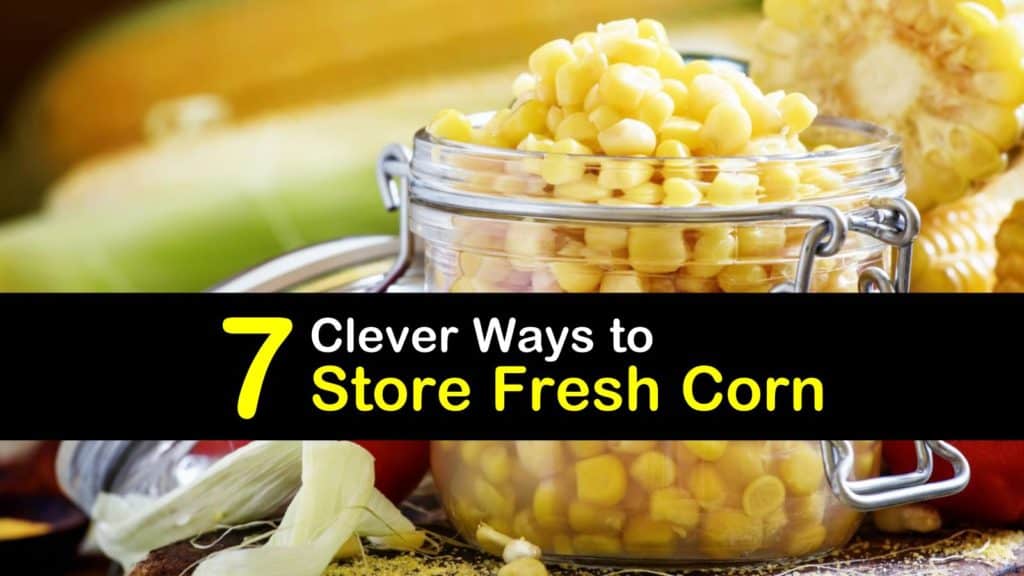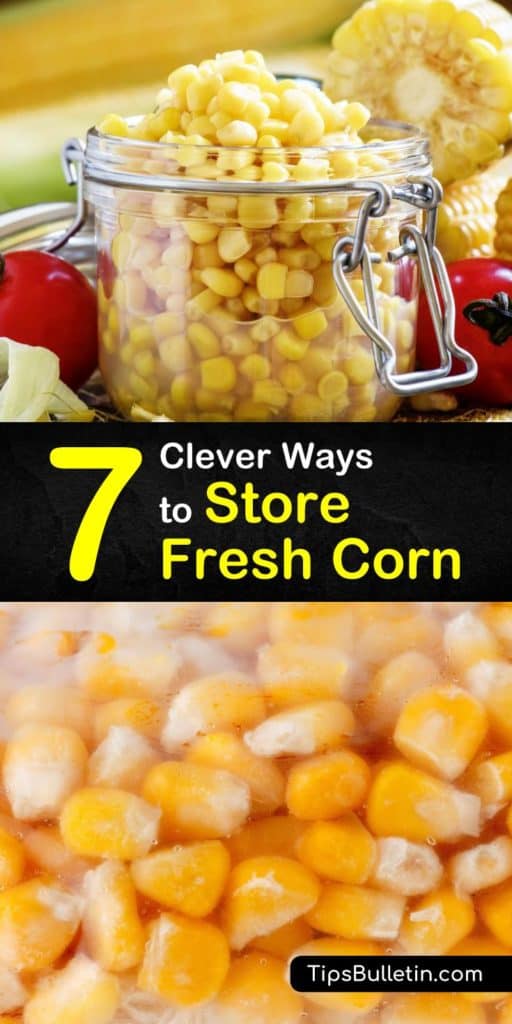As the lazy days of summer start, so does corn season, and we get the pleasure of eating buttery cobs of corn through the beginning of fall. However, there are various ways to enjoy this tasty vegetable even longer. Learn how to store corn in the fridge, freezer, and pantry to eat, no matter the time of year.
Fresh corn on the cob signifies long days of sunshine, backyard barbecues, and outdoor fun with family and friends. There is nothing better than munching on an ear of corn drizzled with melted butter and a sprinkling of salt while relaxing beneath the summer sun.
However, sweet corn isn’t reserved solely for the summer-time. There are many ways to store whole ears of corn in the kitchen to keep it fresh and prevent the kernels from losing their crisp texture and sweet flavor. Several methods keep corn delicious, even in the cold months of winter.

Ways to Store Corn on the Cob and Corn Kernels
While pulling back the husk of a freshly roasted ear of corn is a favorite way to eat this vegetable, it only lasts so long after harvest.
Luckily, the fridge, freezer, and pantry offer alternative methods to keep corn fresh at different times of the year, as well as how to store beans, and other fruits and vegetables.
Where to Store Corn on the Cob?
Fresh corn is the best, but knowing where to store corn on the cob is key to preventing whole ears from drying out. There are a couple of ways, but the fridge is the quickest for the short term.
Whole Corn Storage
It’s important to store fresh corn on the cob with the green husks intact to prevent moisture loss. After harvesting, corn quickly dries out, and the sugars turn to starch.

Place the unwashed cobs, with husks in place, in a plastic bag, and seal it after pressing out the air. Set it in the crisping drawer of your fridge for up to three days.
Storing Corn Kernels in the Refrigerator
Removing the cob’s kernels as a preference or recipe addition causes them to lose their juiciness. However, the refrigerator is ideal for storing corn kernels if you plan on eating them within a couple of days.
Shuck the corn, discard the husks, and rinse the cobs under cold water. Place an end of the corn cob in the central opening of a Bundt pan to keep it in place and use a sharp knife to slice downward to remove the kernels.
Continue doing this with each corn cob until the pan is full of kernels. Scoop the veggie morsels into a container, put the lid in place, and store corn in the fridge for about three days.
How to Store Corn after Cooking
The best way to store corn after cooking, whole and in kernel form, is in the fridge to eat within three to five days. The freezer is a good alternative if you prefer to eat it at a later date.
What about onions? Where do you store onions after slicing? Both of these preservation methods work for onions, too.
Place the cooked corn into a container, secure it with a lid, and set it on the refrigerator shelf. To freeze it, pour the kernels into a freezer bag, press out all of the air, and seal it shut. Write the date on the bag and lay it flat in the freezer.
How to Freeze Corn on the Cob
Freezing fresh corn on the cob is a great way to enjoy a good harvest well into the months of winter. The only difficult thing is locating space in your freezer.
Pour cold water into a large bowl, fill it with ice cubes, and set it aside. Pour hot water into a large stockpot and bring it to a low boil. Remove the husks from the corn cobs and place them in the boiling water for five to seven minutes to blanch them.
After blanching, transfer the corn to the ice water bath to cool for about seven minutes. Dry the cobs with a clean towel and place them into freezer bags.
Press out as much air as possible before sealing and labeling them. Store them on the freezer shelf for up to one year.
Preparing and Freezing Corn Kernels without Blanching
If there isn’t enough room in the freezer to store whole corn cobs, try cutting off the kernels to freeze them in portions. Can you freeze corn without blanching it first? Yes, frozen corn is easy to cook in a pan of boiling water or a steamer.
Remove the husks from the corn and hold them upright, with the flat side on a cutting board. Use a medium-sized knife to remove the kernels from the cob by sliding it from top to bottom.
Repeat with each cob and then place the corn kernels into a freezer bag. Use your hands to push out the air before sealing the bag and then lay it flat on the freezer shelf for up to one year.
Making and Storing Canned Corn
Making a batch of canned corn is a great way to use up fresh corn before it goes bad. It is healthy and delicious and is convenient to store in the cupboard or pantry.
While canning corn on the cob is one option, canning kernels is even better. Shuck the corn cob and remove the kernels by holding the cob upright on a cutting board and slicing a knife from top to bottom.
Pack the corn kernels loosely into each canning jar, along with a half teaspoon of canning salt, leaving an inch of headspace.
Bring a medium pot or tea kettle of water to boil and pour the boiling water into each jar. Use a knife or utensil to remove any air bubbles and screw the lids in place.
Load each jar into a prepared pressure canner, lock the lid, and bring the water to boil on medium-high heat. Steam the vent for ten minutes, close it to heat to ten pounds of pressure, and process the jars at this pressure for 55-minutes.
Turn the heat to off and let the pressure drop naturally. Once it reaches zero, open the vent, remove the lid, and let the jars cool for ten minutes or so before transferring them to a cooling station.
How to Make Pickled Corn Relish
If you have more corn than you know what to do with, consider making pickled corn relish. This condiment is versatile and a great topping on hot dogs, hamburgers, and brats.
Place the onions, peppers, and cucumbers into a food processor and pulse three or four times. Pour the veggies into a large pot along with the corn, seasonings, and vinegar and bring it to a boil.
Reduce the heat and cook for about 25-minutes. Pour the relish into a large jar, screw the lid in place, and refrigerate it for four to six weeks.
While it’s easy to think of corn on the cob as a summer-only treat, storing them in the freezer makes them a wintertime delight as well. Not only does corn hold up well frozen, but there are a variety of recipes for canned corn to lengthen its shelf-life.

Knowing how to store corn in various ways means that you get to enjoy this sweet vegetable longer, so why not share our corn storage tips and recipes with your circle of friends on Facebook and Pinterest?